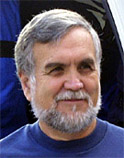|
Ronald Greeley
–
geologist
|

|
"
. . . for me creativity involves curiosity about the world
(and worlds) around us, the stimulus of new observations, and
interactions with other people who are also curious."
|

|
| |
|
|
|
| |
How were you motivated to become a geologist? |
| |
I have always been interested in natural history. My father was in the service
and we moved around a great deal––I think I was in 14 different schools before
finishing high school. This mobility gave me an opportunity to see many
different parts of the country and to recognize differences and similarities in
landforms, trees, animals, etc. Particularly important was a trip my family
made moving from Illinois to California when I was in the seventh grade. We
took time to visit most of the national parks along the way, often diverting to
sites such as Carlsbad Caverns. Dad was particularly good about stopping the
car so that I could collect rocks and look at formations exposed in road cuts.
Although I was by no means concentrating on earth science at that time,
certainly the opportunity to see so much classic geology made an impression.
In my junior year of high school, I knew that it was time to focus on a
specific area of natural history. For a while, I thought about becoming a park
naturalist but learned that the path to that career required a degree in a
specific science. Ultimately, my decision to pursue geology was made by
considering the aspects I liked most– the outdoors, rocks and minerals,
geography, plants, and animals (as fossils). After finishing my Bachelor of
Science degree in geology, I concentrated on paleontology with close
connections to biology in graduate school. As part of my program of study, I
spent a summer at a marine laboratory, studying the modern (living) forms of
the fossil groups that I was researching in the rock record.
After finishing my Ph.D. in 1966, I worked for Standard Oil Company of California
for a year as a paleontologist. However, I had a military obligation to fulfill
and was called to active duty as an officer. I was assigned to NASA as a
Research Scientist at Ames Research Center. My work there had nothing to do
with paleontology, but because I had a solid background in geology and remote
sensing, I was assigned to carryout work dealing with geology in preparation
for the Apollo landings on the Moon. My interests later expanded to include
Mars, Jupiter and beyond. Today, I tell my students at Arizona State University
to do well in ALL of their studies, because you never know what you might end
up doing. At the same time, it is ironic that paleontology is now important in
the exploration of Mars (and elsewhere in the Solar System) in meeting NASA's
goals for the search for life. Perhaps I will be able to put my early studies
of the fossil record to use when rock samples come back from Mars!
|
|

|
| |
|
|
|
| |
What can you share about your creative process? |
| |

|
|
Scientists are often asked how they get their ideas. On the one hand, this is
an easy question to answer, but on the other hand, it is difficult and complex.
From the simple perspective, we see things around us, and we want to understand
what we see. Have you ever wondered why mountains come in different sizes and
shapes? Or, what's involved in their formation and how do they change with
time? In other words, we tend to be stimulated by nature and our own curiosity
as part of the creative process.
On a more complex level, in planetary science we live in a unique period of
exploration. In the last quarter century, we have had the marvelous opportunity
to see new worlds for the first time. Never before, and never again will there
be the chance to see the primary Solar System objects as a "first! " These first
views provide an enormous stimulus and create a "drive" to want to understand
what we are seeing. How do those erupting volcanoes on Io, a moon of Jupiter,
work? What caused the rivers on Mars to dry up? Why are the volcanoes and
canyonlands on Mars so big in comparison to similar features on Earth? The list
of questions is nearly endless. And each time we send a new voyage of
exploration to the planets, we get more data which generate even more
questions.
How are these questions answered? Few scientists work in isolation, especially
in planetary science. Most missions involve teams of scientists working
together to design experiments, plan observations, and analyze the data when
they are returned to Earth. In the early stages, ideas are proposed, discussed,
and usually rejected. Although occasionally someone may come up with a
brilliant answer the first time, mostly solutions require much discussion and
'testing' before a valid answer is found. In my own case, in addition to
discussions with colleagues, interactions with our students are particularly
important for bringing out fresh ideas.
The creative process also involves adaptations of old ideas to new problems.
For example, when the first images were returned from Mars showing sand dunes
and other wind–related features, I became interested in how sand and dust might
behave in the thin Martian atmosphere. The classic work on windblown sand on
Earth had been written more than 30 years earlier by a British military
engineer who used a wind tunnel in his studies. It seemed to me that a similar
approach could be used to study wind processes on Mars, but with adaptations to
the Martian environment. Although the gravity, atmosphere, and other conditions
are quite different, the basic process seemed to be same. Through a team of
planetary geologists, atmospheric scientists, and engineers, a wind tunnel was
put into operation which enabled us to understand how sand and dust is moved by
winds on Mars and provided insight into the resulting geology. This facility is
still used for related experiments, as well as for testing spacecraft
components and instruments in a simulated Martian environment.
So what is the creative process? That is difficult to define, but for me, it
involves curiosity about the world (and worlds) around us, the stimulus of new
observations, and interactions with other people who are also curious.
|
|
| |
|
|
|
| |
What ideas do you have for a future human community on Mars?
|
| |
I envision the first communities on Mars to be outposts for exploration. The
surface of Mars is just about equal to the land area of Earth. Think what it
will take to explore the Red Planet thoroughly! Although our current
exploration using orbiters, landers, and small rovers is providing a fine
reconnaissance, we will not truly understand Mars until humans can roam over
the surface and study its characteristics up–close and in detail. To me, this
means that we need communities that serve as base stations from which humans
and robots set out on paths of exploration, much like scientists do in
Antarctica today. Many of these forays might include sending robotic airplanes,
balloons, and rovers directly from the communities or from human base camps set
up in other key locations. In the Mars "home community" there should be full
analytical laboratories to study the samples and other data returned from the
expeditions.
Why not just complete the exploration of Mars by robots controlled from Earth?
Because of the communication lag time between Earth and Mars, operating even a
simple robot doing the simplest of tasks is frustratingly slow. Future
technology will help with some of these problems, but there will always be
limitations that can be overcome only by human presence, in which people can
react to new discoveries on Mars in real time, and make decisions that cannot
be made by machines.
In the early exploration of the American West, many of the expeditions were led
by, or involved, geologists. These scientists had broad training in field
studies and often were able to synthesize complex natural systems. It was for
this reason that the first (and only!) scientist–astronaut sent to the Moon was
a geologist, Harrison "Jack" Schmitt. It is likely that geologists will also be
among the first humans to set foot on Mars in order to carry out extensive
exploration projects. As part of early exploration, essential resources such as
water and minerals needed to support Martian communities will be sought.
Consequently, a high priority in the development of the communities should be
the infrastructure to enable exploration activities.
ASU and Planetary Geology web links:
http://www.asu.edu/
http://geology.asu.edu/
http://europa.la.asu.edu/
http://europa.la.asu.edu/greeley
|
|

|
|




